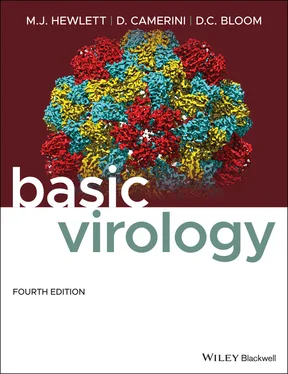Other complications arising from persistent infections
Persistent infections caused by some viruses can (rarely) lead to a neoplasm(a cancerous growth) due to continual tissue damage resulting in mutation of cellular genes controlling cell division (i.e., oncogenesand tumor suppressor genes). Examples include infections with slow‐transforming retroviruses such as human T‐cell leukemia virus ( HTLV ), chronic hepatitis B and hepatitis C virus infections of the liver, certain genital papilloma virus infections, and EBV infections. The latter require the additional action of auxiliary cancer‐causing factors ( co‐carcinogens ).
Autoimmune diseasessuch as multiple sclerosis(MS) are thought by many investigators to result from an abnormal immune response to viral protein antigens continually present in the body due to a persistent infection. Such persistent infections need not result in the reappearance of infectious virus. For example, infection with measles virus usually leads to rash and recovery, although portions of viral genomes and antigens persist in certain tissues, including neural tissue. The mechanism of this persistence is not fully understood, but it is clear that virus maturation is blocked in such cells that bear viral genomes, and viral antigens are present in reduced amounts on the cell surface. The presence of antigen leads to lifelong immunity to measles, but it can result in immune complications where the host's immune system destroys otherwise healthy neuronal tissue‐bearing measles antigens.
The fatal disease of subacute sclerosing panencephalitis ( SSPE ), which is a rare complication in children occurring a few years after a measles infection, is a result of such an autoimmune response. SSPE is a rare outcome of measles infection, but other severe sequelae of measles are common. One of the most frequent is damage to eyesight. The virus replicates in the host and infects surface epithelium, resulting in characteristic rash and lesions in the mouth, on the tongue, and on the eye's conjunctiva. Virus infection of the conjunctiva can clear, but movement of eye muscles in response to light, or in the process of reading, can lead to further infection of eye musculature, leading to permanent damage, which is why individuals infected with measles should be protected from light and kept from using their eyes as much as possible.
Viral and subviral diseases with long incubation periods
Most virus‐induced diseases have low or only moderate mortality rates. Obviously, if a virus's mortality rate is too high, infection will kill off all the hosts so rapidly that a potential pool of susceptible individuals is lost. Exceptions to this rule do occur, however. Introduction of viral disease into a virgin population (perhaps due to intrusion into a novel ecosystem) can lead to high mortality. Prime examples are the spread of smallpox in Europe during the Middle Ages, and the destruction of native populations in the Western Hemisphere by the introduction of measles during the era of European expansion. Another exception to the low‐mortality rule comes about as a manifestation of infection with a virus that has an unusually long incubation period between the time of infection and the onset of symptoms of disease.
Some viral diseases have very high mortality rates despite being well established in a population. With rabies, for example, injection of virus via the saliva of an animal bearing active disease leads to unapparent early infection, followed by a long incubation period of two to eight weeks or more depending on the species and individual. During this time, the infected animal is a walking “time bomb.” The symptoms of disease (irritability, frenzy, and salivation) are all important parts of the way the virus is spread among individuals. The very long incubation period allows animals bearing the disease to carry on normal activities, even breed, before the symptoms almost inevitably presaging death appear. A hypothetical viral infection that might lead to these physiological and behavioral changes but that resulted in a quick death could not be spread in such a way.
AIDS, which is characterized by an acute infection by HIV and a latent period in which HIV can be transmitted, followed by severe disease, is an example of a “new” zoonotic viral disease. In humans, virus spread is often the result of behavioral patterns of infected individuals during HIV's long latent period. This pattern of spread makes it unlikely that there is any selective pressure over time toward amelioration of the late severe symptoms of AIDS.
We have noted in Chapter 1that while prions are not viruses, many of the principles developed for the study of viral diseases can be applied to study of the pathology of prion‐associated diseases. The prion‐caused encephalopathiesare, perhaps, the extreme example of an infectious disease with a long incubation period. Periods ranging from 10 to 30 years between the time of exposure and onset of symptoms have been documented. Prion‐induced encephalopathy does not lead to any detectable immune response or inflammation, probably because the prion is a host protein and the CNS is isolated from normal immune surveillance. The course of the disease is marked by a slow, progressive deterioration of brain tissue. Only when this deterioration is significant enough to lead to behavioral changes can the disease be discerned and diagnosed. No treatment or vaccination strategy is available at this time for human prion diseases, but a partly successful vaccine to prevent prion‐mediated chronic wasting disease of cervids (deer and elk) has been developed.
SOME VIRAL INFECTIONS TARGETING SPECIFIC ORGAN SYSTEMS
While all the organ systems of the vertebrate host have important or vital functions in the organism's life, several play such critical roles that their disruption leads to serious consequences or death. Among these are the CNS with its influence on all aspects of behavior both innate and learned, the circulatory system, the immune system, and the liver. Virus infections of these systems are often life‐threatening to the infected individual, and the tissue damage resulting from infection can lead to permanent illness or death. For example, destruction of CD4+ T cells of the immune system by HIV is the major symptom of AIDS and leads in >90% of untreated cases to death from opportunistic infectionsand neoplasms. Other viruses can cause as devastating a disease as HIV, but most viral infections are not as often fatal. A consideration of some CNS and liver virus infections provides some interesting examples of both destructive and limited disease courses.
The different patterns of sequelae following infection of a common target organ are also important demonstrations of several features of virus infection and pathogenesis.
First, specific tissue or cell tropism is a result of highly specific interactions between a given virus and the cell type it infects. Depending on the type of cell infected, the severity of symptoms, and the nature of the damage caused by the infection, different outcomes of infection are evident.
Second, persistent infection is a complex process. It is, in part, the result of virus interacting with and modulating the host's immune system. Often, persistence involves the virus adapting to a continuing association with the target cell itself.
Читать дальше












